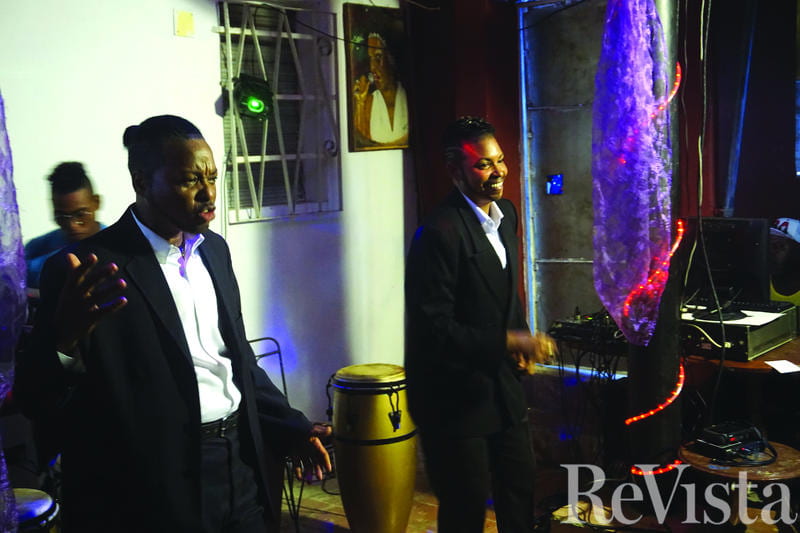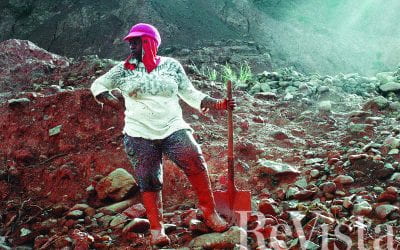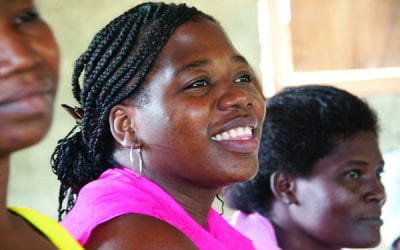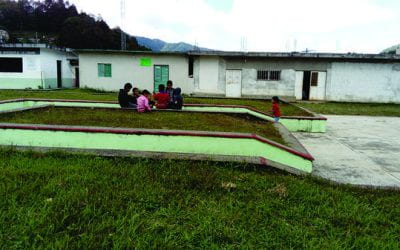Transforming Havana’s Gay Ambiente
Black Lesbian Gender Performers and Cuba’s Sexual Revolution
The epicenter of Havana’s gay ambiente might be La Rampa—a stretch of Calle 23 in the touristy El Vedado neighborhood— but the peripheral neighborhoods of Havana are also home to drag shows and other queer nightlife. Recently, my friends Argelia and Ana invited me and my partner to see them perform at a privately run party in the neighborhood of Párraga on the outskirts of Havana. Párraga is roughly seven miles south of El Vedado and a journey of at least an hour on multiple city busses. We met up with our friends—a black lesbian couple who also perform as drag kings—caught a bus to Párraga, climbed a steep hill on foot, and followed the sound of music at the end of the block to reach the party.
The venue was handsome, an open space in the patio and backyard of a large house with tables and chairs, a bar and a small stage. That night, perhaps as a result of my friends’ appearance, an audience made up mostly of Afrodescendent lesbian women arrived behind us. This already differentiated the event from most of those in the El Vedado nightclubs, where the audience is predominantly gay male. We spent the night sharing a table with a group of women who had participated at one time or another in Grupo OREMI, the network of lesbian and bisexual women of the National Center for Sex Education (CENESEX), the most prominent player in Cuba’s sexual revolution.
One of these women told us that she lived in the Playa neighborhood, meaning she had traveled even further than we had to come to the party. When I asked her why she had come such a long distance when there was desirable nightlife in her neighborhood, she responded that she felt she could have a better, more relaxing, and less costly night in Párraga than at any club in the city center. I imagined that this had something to do with the conspicuous absence of tourists in this space. The gay parties in El Vedado are characterized by the tourists who attend them and the jineteros or hustlers who chase after them. These parties represent a heavily male, transnational and commercial scene. In Párraga, however, my partner and I were possibly the only non-Cuban citizens, and in our solitude we did not attract a great deal of attention.
In my fieldwork for my Ph.D. dissertation on race, gender performance, and sexual revolution in Cuba, I focus on the barriers these black lesbian drag performers face in finding steady work as gender performers. While drag queen performance has flourished in Havana in recent years, brought above ground by the state’s more accepting approach toward nonnormative sexualities that is often described as a “sexual revolution,” Havana’s drag king scene is just getting off the ground. This lag is indicative of one aspect of the sexual revolution that has been criticized for its failure to fully include lesbian women in its drive for change. The nascent drag king scene emphasizes the need for lesbian space in Havana, and it calls attention to how the changes brought about by the sexual revolution have not made a sufficient impact on the lives of working-class and Afrodescendent Cubans.
Back at the party, my partner and I settled in to listen to our friends perform “Mientes” by the Mexican group Camila: the women emerged from backstage with their hair slicked back and facial hair carefully pasted on to their faces. They wore three-piece suits, shirts and ties. When they reached the chorus, the audience shouted along at full voice, a somewhat ironic performance given that my friends were silently lip-synching to the recording. This kind of anthemic song is a typical opener for them: they will often begin with a romantic piece, pass through some salsa or reggaetón, and finish with rumba, animating their audience bit by bit over the course of their selections. True to form, they closed their portion of the show with “Estoy aquí” by the famed folkloric ensemble Yoruba Andabo. By this point, the public was primed to jump to their feet, dance with the performers, and break the barrier between audience and artist.
This was not the only folkloric element of the night. One day a week, this establishment hosts an afternoon rumba performance, and on this occasion the rumberos came the night before to play a set of songs for the orishas, deities in the Yoruba religion Regla de Ocha. Dancers sat on stage dressed as various orishas, waiting for their canto to sound. Among them was the drag queen who runs this party, who was dressed as Yemayá. As her song began, she rose, dancing and swirling so her blue and white dress resembled the foam of the ocean over which Yemayá presides. Women dressed as Obbatalá and Ochún also rose and danced when their respective orishas were called. The audience responded with particular enthusiasm to this part of the evening, stuf ng tips in the dresses of the performers. While Afro-Cuban cultural production and folkloric elements are not absent from the stages of Havana’s downtown performance, this kind of dwelling on Afrodiasporic themes was certainly more than would be typical on La Rampa.
We stayed with our friends at the party until the first city buses would start running in the neighborhood a little after 4 a.m. We waited a long while on a street corner near the party and eventually caught a bus back to the hub. There our two friends caught another bus to nearby Mantilla—where they live—and we caught one back to El Vedado along with the various performers who lived in Centro Habana and our neighborhood. We checked in with our friends when we got off the bus, and they were already home, settling in to bed just before 6 a.m., which is relatively common for gender performers in Havana.
Neighborhoods like Párraga are often referred to as the “barrios marginales” of Havana, referring to both their geographical placement in relation to the city as well as the socioeconomic status of their residents. The marginal nature of these neighborhoods is reflected in the lives and work of female gender performers in Havana. While they do occasionally appear in mainstream gay nightclubs, they more often perform at early evening performances known as peñas or at parties on the outskirts of the city, where they also live. They face considerable economic and social hardships: Not long before our night spent together in Párraga, the cement column that supported their water tank in their back patio collapsed, making it considerably harder for them to store and access the water that comes in from the city once a day. A couple of months later, the effects Hurricane Irma exacerbated existing problems with electricity and leaking in their old wooden house. And all the while they had been caring for Ana’s father as he suffered from dementia and finally passed away in October.
Tellingly, these are also the characteristics that put them on the periphery of Cuba’s sexual revolution, which has catered to gay men, cozied to the spending of tourism, and underplayed the linkages between racism and homophobia in Cuba. By contrast, the nascent drag king performance in Havana has been led by working-class black lesbians whose explicit aims are to combat lesbophobia and generate sorely needed lesbian spaces in Cuba’s capital. They often clearly articulate that their consciousness comes from their marginal position as black, working-class, lesbian women.
When I ask my interlocutors why they do drag performance, they often tell me they do it to show that they—as women—can. While it is easy to think of gender performance as a liberating practice that promotes gender fluidity, it is important to understand it as well as an industry that is dominated by men—drag queens, artistic directors, and nightclub owners—and too often adheres to rigid gender norms. Male performers in Havana are often expected to arrive in masculine garb so as to appear “normal” and to highlight the transformation into their stage persona.
The performativity of this masculinity, however, gets obscured as they step out on to the street and blend in to the larger canvas of gender presentation in Havana. By contrast, female gender performers put that masculine veneer on stage to be ogled, applauded, laughed at. Their transformation underscores the fluid and performative nature of masculinity more generally and takes place in a context in which men have disproportionate access to the formal portion Cuba’s tourist economy and the better-paying jobs that characterize it.
Nevertheless, drag king performance remains an unrealized proposition in Havana. My friends have had a frustratingly difficult time securing steady work as gender performers in the city, as male hosts and artistic directors often prefer to hire the glamorous drag queens to which gay male audiences are accustomed. It also remains to be seen whether and how their work gets folded into Cuba’s sexual revolution. At the 10th Jornada Contra la Homofobia y la Transfobia in May of this year, my friends—who have also become important interlocutors for my dissertation—performed at the nationally televised Gala Contra la Homofobia in the immense Karl Marx Theater, becoming the first drag kings ever to have done so. However, the announcer failed to point out that the people on stage were female gender performers, and many spectators assumed they were men. It is unsure whether they will be invited to perform at the 11th Jornada in May 2018 and whether it will be made clear to the audience that the artists they are enjoying are black lesbian women performing masculinity as a job in Cuba’s challenging economy.
Winter 2018, Volume XVII, Number 2
Matthew Leslie Santana is a Cuban-American music scholar and performer from Miami, Florida. He received a Doctor of Musical Arts from the University of Michigan in 2015 and is currently pursuing a Ph.D. in ethnomusicology at Harvard University.
Related Articles
Afro-Latin Americans: Editor’s Letter
My dear friend and photographer Richard Cross (R.I.P.) introduced me to the unexpected world of San Basilio de Palenque in Colombia in 1977. He was then working closely with Colombian anthropologist Nina de Friedemann, and I’d been called upon by Sports Illustrated to…
Witches, Wives, Secretaries and Black Feminists
The issue of gender has been front and center for me, both as a subject of my fieldwork on black politics in Latin America, and how I conducted that research, particularly in how I…
Compañeros En Salud
English + Español
I have lived in non-indigenous rural Chiapas in southern Mexico since 2013, working with Compañeros En Salud (CES)—a Harvard af liated non-profit organization that partnered with…





